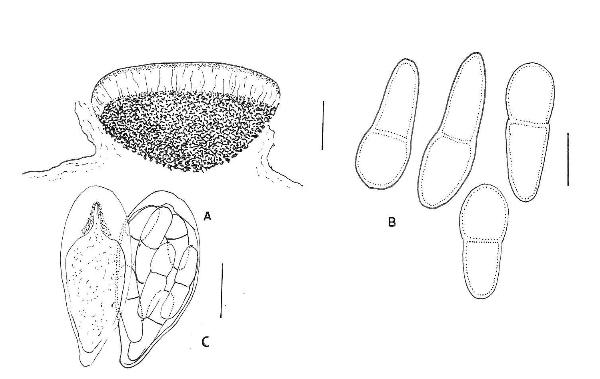Arthonia squamarinae Etayo
Cryptog. Mycol., 29: 69, 2008.
Synonyms:
Distribution: C - Tosc (Brackel 2015, 2016), Sar (Brackel & Berger 2019).
Description: Thallus inapparent, not lichenized, forming discoloured patches on the thalli of Squamarina-species. Apothecia arthonioid, emarginate, black, epruinose, convex and cushion-like, irregularly rounded to slightly lobulate, at first immersed, then erumpent through the cortex of the host lichen, finally sessile and sometimes slightly constricted at base, 0.3-0.5 mm across, up to 150 μm tall. Proper exciple very poorly developed; epithecium olive-brown, K+ intensifying green, N-; hymenium colourless to olive-green, 40-50 μm high, I+ red, K/I+ red; paraphysoids branched and anastomosing, the apical cells slightly swollen; hypothecium dark olive brown, K+ greenish, N-. Asci (2-4-)8-spored, broadly clavate, semi-fissitunicate, with a large apical dome and a distinct ocular chamber, Arthonia-type. Ascospores 1-septate, with a cell wider and longer than the other, not or only slightly constricted at septum, hyaline, soleiform, (12.5-)13.5-17(-20) x 4.5-5.5 μm, smooth-walled, without a gelatinous perispore. Photobiont absent. Spot tests: thallus K-, C-, KC-, P-, UV-. Chemistry: without lichen substances.Note: this lichenicolous fungus was known so far only from a few localities in Spain and France, where it was found on the thallus of Squamarina lentigera and S. cartilaginea; the sample from Tuscany was on S. gypsacea, that from Sardinia on S. lentigera.
Growth form: Lichenicolous fungus
Substrata: rocks, soil, terricolous mosses, and plant debris
Reproductive strategy: mainly sexual
paras Squamarina spp.
Commonnes-rarity: (info)
Alpine belt: absent
Subalpine belt: absent
Oromediterranean belt: absent
Montane belt: absent
Submediterranean belt: absent
Padanian area: absent
Humid submediterranean belt: extremely rare
Humid mediterranean belt: extremely rare
Dry mediterranean belt: absent

Predictive model
Herbarium samples
Growth form: Lichenicolous fungus
Substrata: rocks, soil, terricolous mosses, and plant debris
Reproductive strategy: mainly sexual
paras Squamarina spp.
Commonnes-rarity: (info)
Alpine belt: absent
Subalpine belt: absent
Oromediterranean belt: absent
Montane belt: absent
Submediterranean belt: absent
Padanian area: absent
Humid submediterranean belt: extremely rare
Humid mediterranean belt: extremely rare
Dry mediterranean belt: absent

Predictive model
| Herbarium samples |
 INDEX FUNGORUM
INDEX FUNGORUM
 GBIF
GBIF


